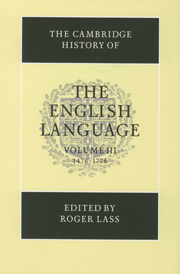7 - LITERARY LANGUAGE
Published online by Cambridge University Press: 28 March 2008
Summary
Introduction: the scope of this chapter
The rise of a national Standard language in the period 1476–1776 (see Görlach this volume) had its literary counterpart in the formation of a national literature, embodied in the works of those whom influential opinion identified as the nation's ‘best authors’. Indeed, the codifying of language and the canonising of literature were not merely simultaneous but symbiotic processes, with the ‘best authors' being quarried for instructive examples as much by grammarians and language teachers as by rhetoricans and literary critics. Dr Johnson, for instance, advised prospective readers of his Dictionary that ‘the syntax of this language … can be only learned by the distinct consideration of particular words as they are used by the best authors' (Johnson 1747: 19). And Johnson's was not an innovative attitude. He was simply ratifying an alliance between Literary English and Standard English that was already being negotiated almost two centuries earlier. For when Puttenham advises sixteenth-century poets to write in ‘the vsuall speach of the Court, and that of London and the shires lying about London within lx. myles, and not much aboue’ ([1589]: 145), his sixty-mile radius draws the boundary not of a homogeneous regional dialect, but rather of an emerging establishment variety, centred on the Court and London and circumferenced by the universities of Cambridge and Oxford and the main seat of ecclesiastic power at Canterbury.
The tradition represented by Puttenham and Johnson has proved a powerful one, gaining in strength as it became institutionalised in the syllabuses of nineteenth-century schools and twentieth-century universities. But in the academic debates of more recent years, its restrictive definition of literature has come under attack.
- Type
- Chapter
- Information
- The Cambridge History of the English Language , pp. 539 - 653Publisher: Cambridge University PressPrint publication year: 2000
References
- 5
- Cited by

